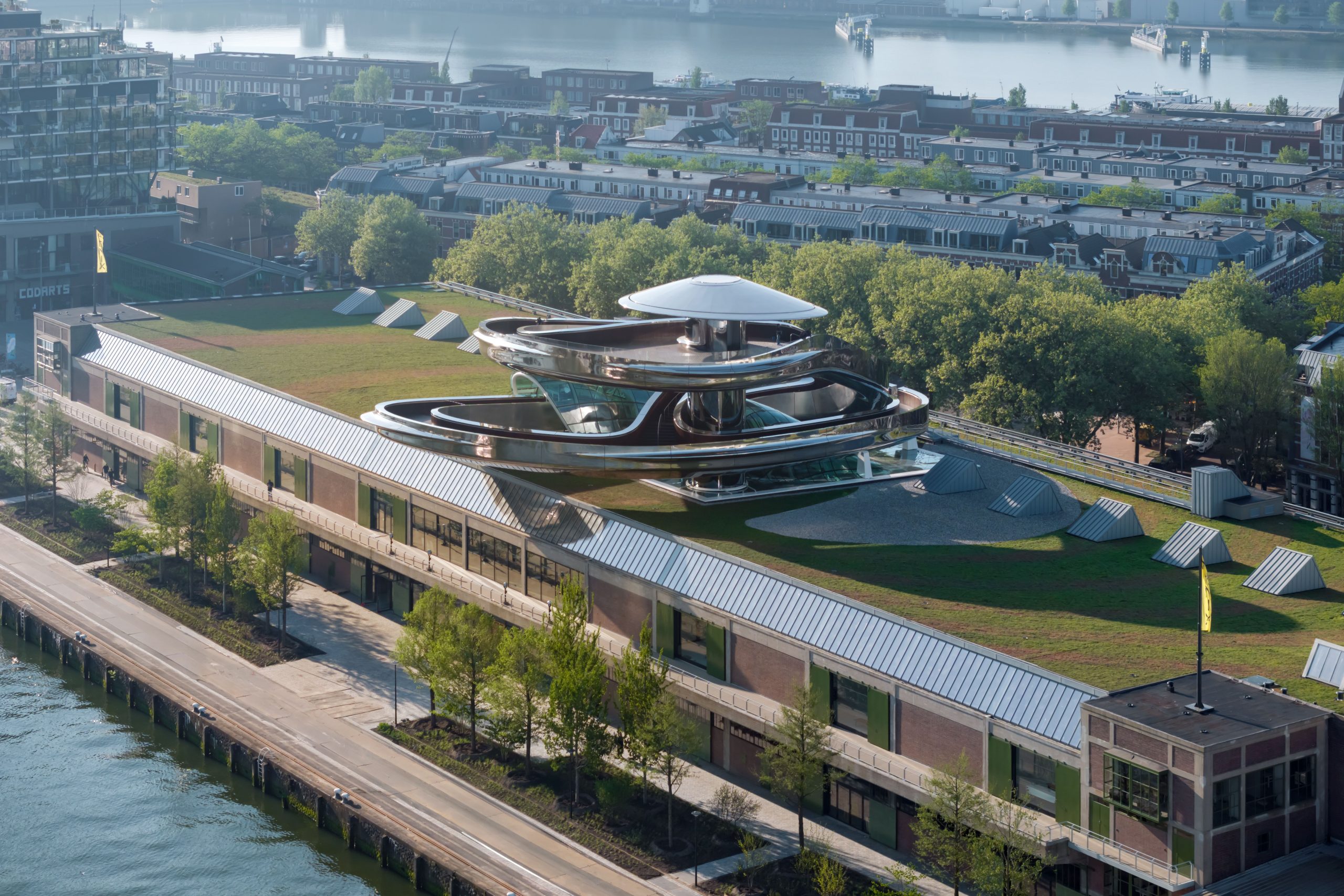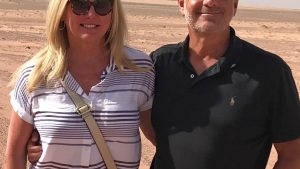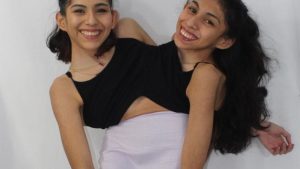
Art in All Directions: The Fenix Museum Is Changing How We Talk About Migration
On the banks of Europe’s largest port—and at the former site of the continent’s first Chinatown—a gleaming double helix coils above a former warehouse in Rotterdam’s Katendrecht district. This sculptural staircase, designed by Chinese starchitect Ma Yansong of MAD Architects and dubbed “the Tornado,” anchors the newly opened Fenix Museum of Migration.
It’s a showstopper, but more than that, the structure poses a question: What does it mean to leave, to arrive, and to begin again?
It’s a sticky June afternoon when I reach the Fenix. Inside the sunlit lobby, the Tornado glows, its polished steel and warm wood spiraling skyward. You can ride an elevator to the building’s roof, where there is a cantilevered viewing platform, but most visitors opt for the climb. I follow a young family with a toddler who squeals as he bangs on the paneling and crawls up the ramp. It feels like boarding a futuristic cruise ship.
When Ma first visited the site, it struck him as “chaos—in a good way”; a run-down, low-slung building ready to be cracked open. “I want to break it,” he recalls thinking. We are speaking over Zoom, he from his office in Beijing. “I don’t want to destroy it…I want to show this energy that goes up and through the roof and into the sky.”
Unlike other migration museums that rely on historical documents and artifacts to explore the impact of human movement, the Fenix tells that story through art. Here, a life-sized soft replica of a New York City bus by Red Grooms shares a floor with Space Refugee, a 2019 sculpture by the Syrian artist Omar Imam; and paintings by Hans Holbein the Younger are displayed alongside work by the Dutch abstract artist Willem de Kooning, who immigrated to the United States from Rotterdam in the 1920s.
Upon entering the museum, visitors are greeted by two free exhibitions in the lobby: “The Family of Migrants,” a striking display featuring more than 100 photographs of people on the move, and “Suitcase Labyrinth,” a maze crafted from 2,000 pieces of luggage collected from around the world. Next door, a covered public atrium called Plein hosts free programming from local community groups, ranging from salsa and bachata lessons to a Moroccan market.
Eva Besnyö, United States, 1938. The maiden voyage of the steamship Nieuw Amsterdam. Passengers gaze from the deck towards an approaching ferry.
© Maria Austria Instituut
While migration is often depicted in modern media as a dark and traumatic process, Ma wanted the Fenix’s physical environment to feel hopeful, light, even playful. “The intention [is] for more freedom,” he says. “You’re inside a container and then you break it. You go up and then you see a view that you can never see from inside the building.” As visitors ascend the Tornado, he wanted them to experience a “transition from old, dark, to hope and light and happiness.”
Indeed, stepping out onto the roof gave me the feeling of floating over the Maas River, as if on the bow of a ship. I thought of my father, who worked as a merchant marine when I was an infant and docked often in Rotterdam, as well as of the millions who departed Europe here in search of new lives across the Atlantic.
Opened in May, the Fenix arrives at a moment of tension: The Netherlands, long regarded as a beacon of tolerance, is, like other parts of the world, grappling with a shift toward increasingly hardline immigration policies. In that context, the museum feels quietly radical—though its director, Anne Kremers, insists the Fenix’s project isn’t political.
Her goal is to create the friendliest museum in the Netherlands. “Migration is part of our lives,” Kremers tells me. “As long as we exist as human beings, we move, and we will always keep on moving. We really wanted to show that migration is timeless and universal, and not politicized. It’s part of who we are. It’s urgent.”
As one ascends the structure, ramps and staircases intersect and sometimes dip down or veer sharply, mirroring the chaotic, nonlinear journeys migrants take. (When, in the Tornado’s early stages, engineers told Ma that the concept wasn’t buildable, he enlisted roller coaster consultants to help.) At the same time, the reflections of visitors ripple along the heavy metal panels—each one custom-shaped, polished, and fit perfectly with its corresponding piece—echoing the movement of families across generations.
“The reflection is super important,” Ma explains, “to blend into the nature, into the light, into the environment. When people walk on it, they will see themselves. They will see the movement. You see your own shadow traveling through time.”
Kremers considers the Tornado the museum’s “first artwork.” “The Tornado turned out so good that it was both a blessing but also a little bit scary,” she says. “Everything we did had to be just as good as the Tornado.” (Not for nothing, Ma’s original sketch of the structure now graces Fenix mugs and merch in the gift shop.)
Kremers originally imagined a 50/50 curatorial split between art and artifacts at the museum. Eventually, however, the team decided that only objects that underscored migration’s timeless, universal nature should be shown—and most of those were artworks. (Another sprawling exhibition, called “All Directions,” features more than 100 artists interpreting migration through six themes: identity, fortune, border, flight, home, and migration itself.)
Still, a few jarring artifacts command attention: a confiscated refugee boat that carried 19 passengers from North Africa to Lampedusa sits opposite a haunting work by Thai artist Jakkai Siributr about the plight of Rohingya boat refugees in East Asia; and nearby, a U.N. refugee tent lies on the floor, surrounded by photographs of gardens planted in camps around the world.
Because Ma’s vision for the museum involved movement and light, he designed wide-open gallery spaces without walls. “People can move around the space and get so close to the artwork,” he says. “It feels like the art is easy to access and to understand—and you’re a part of it.”
The architect sees the Fenix commission as a full-circle moment; about a decade ago, he submitted for a Rotterdam cultural project and lost. Now, he’s the first Chinese architect to design a museum in Europe. (His next project of this scale? George Lucas’s Lucas Museum of Narrative Art in Los Angeles, expected to open in 2026.)
In all his work, Ma thinks about reconciling the new and the old, finding that the two “enhance each other, and become a new thing that’s more complete.” Such was certainly the case at the Fenix, where his perspective as a stranger in a strange land had everything to do with the project at hand. “It’s like magic,” he says. “I’m from far and a different culture. It gave me the opportunity to bring something totally new.”











